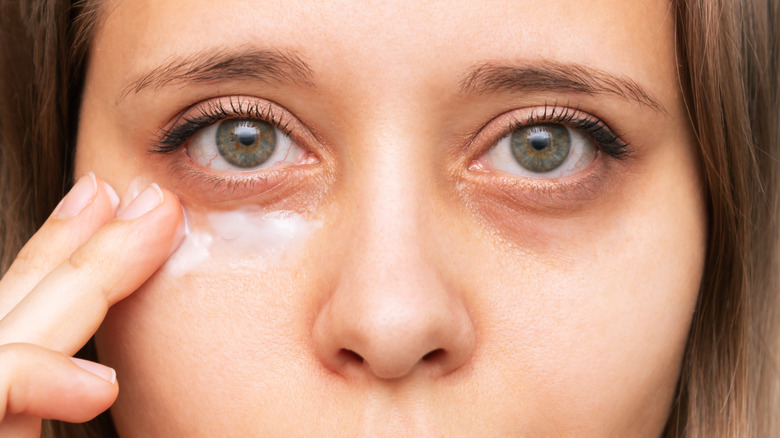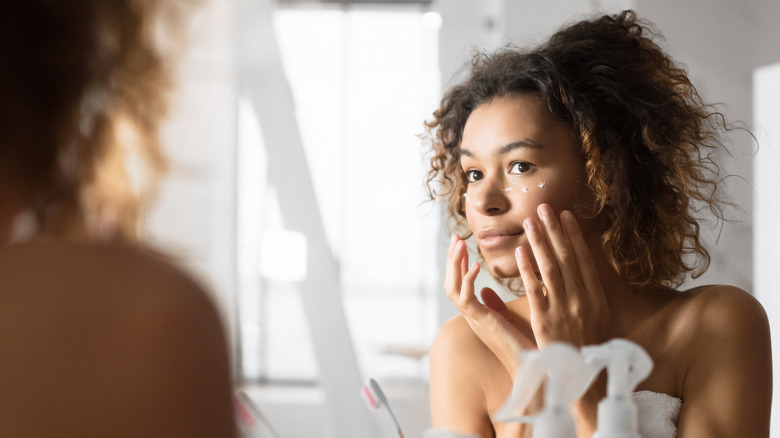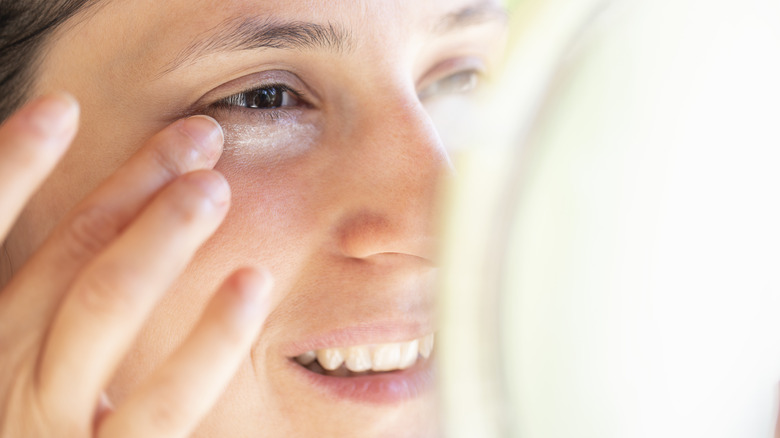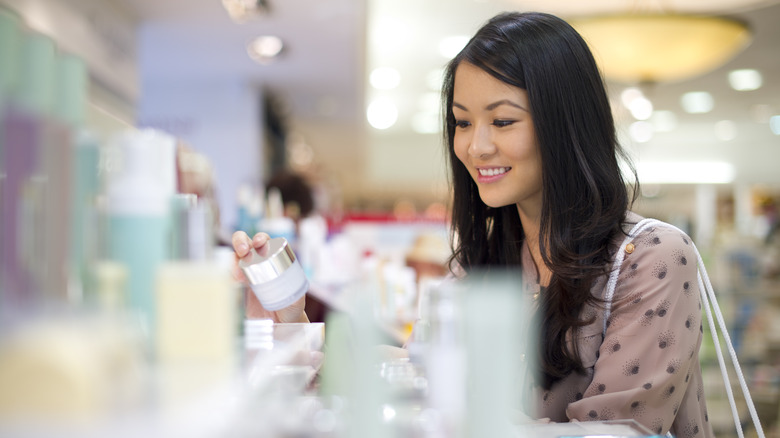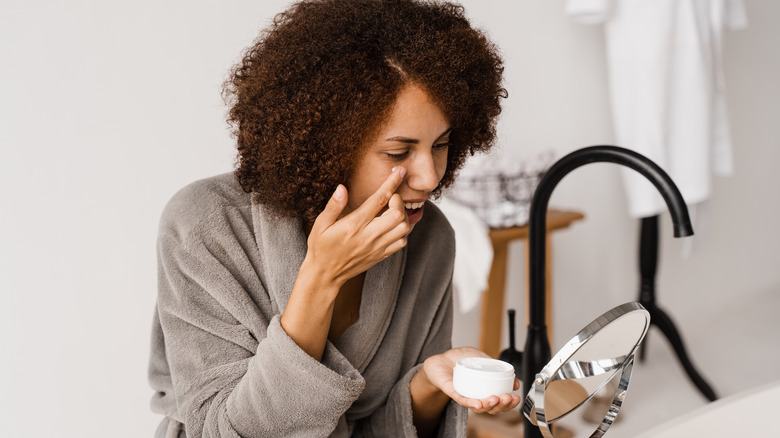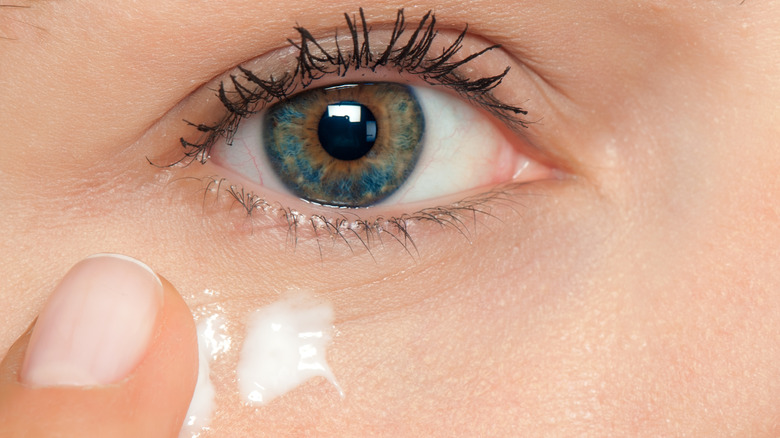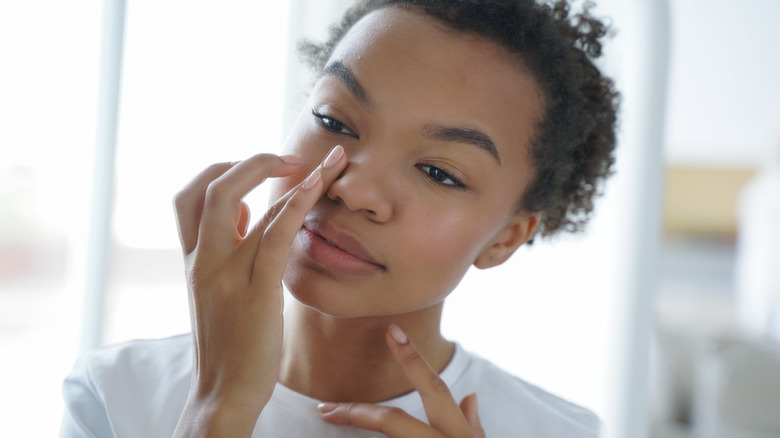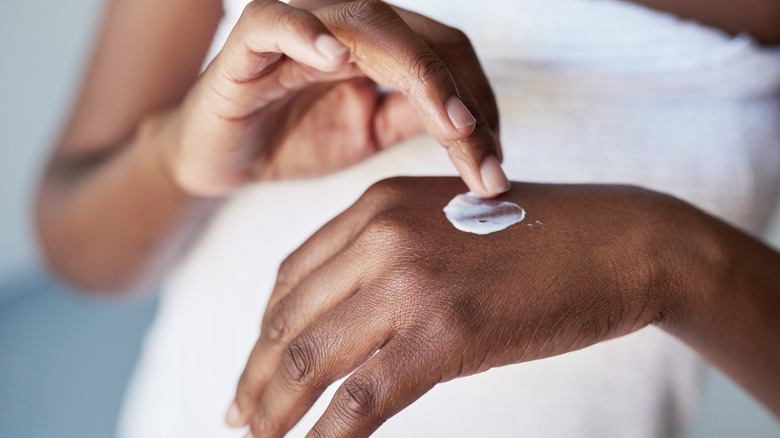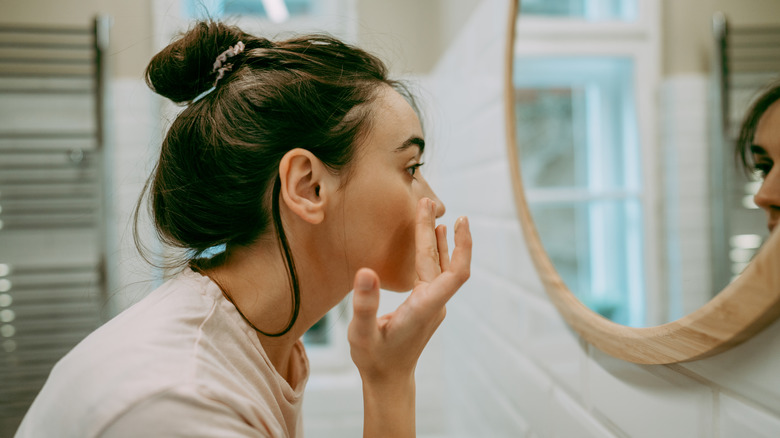What Eye Creams Can (& Can't) Do For You - And Everything In Between
Eye creams. It seems like there's an endless choice of them out there and they all claim to do different things via different ingredients — which can make a trip to the moisturizer aisle totally overwhelming. But, if you feel like you're drowning in a sea of eye cream options, it's time to break free. Women.com is here to help you learn all you need to know about eye creams, including what they can and can't actually deliver for you and how to find what will work best for you.
But before we get into that, let's make sure we're all on the same page with the basics. So, what exactly are eye creams? As board-certified dermatologist Dr. Marisa Garshick put it to Byrdie, "An eye cream refers to a cream that is specifically formulated to be applied to the skin around the eyelid and target undereye concerns." Now that we've got that out the way, let's delve into the nitty-gritty of everything else you need to know about what you're putting around your eye area ... and what you can realistically expect it to do.
There's only so much eye creams can actually do
Though some eye cream marketing campaigns may promise insanely dramatic results that'll make it look like you've got entirely new skin around your eyes, there's really only so much it can do. Unlike cosmetic surgeries, creams are non-invasive, so their effects will always be minimal compared to the more dramatic alternative.
For example, if you're struggling with dark under-eye circles, an eye cream will have the ability to brighten up the area slightly, but it can't work miracles. In many cases, people can mistake dark circles for shadows created by the shape of the eye socket, which an eye cream shouldn't be expected to help. An eye cream also won't be able to thicken the skin, as thin skin around the eyes is often responsible for discoloration. Darkness can also be caused by things like food allergies or even thyroid issues, all of which skincare products can't change either. Equally, for those with eye bags or puffiness under the eye, while an eye cream can be used to soothe the area to lessen any inflammation, it's unable to do anything about the fat deposits that may well be causing them. "What eye creams can't do is remove fine lines, wrinkles, eye bags and droopy eyelids," Nicolas Travis, founder of Allies of Skin, told Stylist.
But there are still a lot of things a good eye product can achieve.
But eye creams do still have a whole host of benefits
Eye creams can't magically give you new skin around your eyes, but they most certainly have their uses. As we already know, they may not be able to totally erase things like dark circles or fine lines, but it's still always worth keeping them in your daily routine.
As board-certified dermatologist Dr. Tiffany Jow Libby explained to Women's Health, "Eyelid skin is 80% thinner than that of the rest of the body, so it tends to be a bit more vulnerable and easily irritated." That's why it's always a good idea to have a moisturizing eye cream in your back pocket to target any dryness or soreness. Not only will this go a long way in keeping you looking more youthful — well-moisturized skin will stay looking younger for longer, after all — but, if you're a cosmetics fan, keeping your eye skin hydrated will also go a long way toward making your makeup look much better. Particularly if dark circles or discoloration is something you suffer from, applying eye cream regularly will create an ideal canvas for your concealer. But there's more! "With the right eye cream, you can improve the appearance of fatigue, dullness and dehydration lines," Nicolas Travis told Stylist of other great benefits.
Exactly what an eye cream can do for you depends on what you want out of it, as that will determine what ingredients you should seek.
How to know which eye cream is best for you
To determine what ingredients you should be reaching for in an eye cream, first work out what issues you wish to combat and what you'd ideally like to achieve. There are numerous main ingredients you can find across various eye products, each with a different purpose. If you're aiming to combat dry skin and focus on hydration, look for something containing hyaluronic acid, niacinamide, glycerin, or ceramides. If you suffer from irritation but still crave moisture, go for something with more soothing ingredients, like vitamin E or chamomile.
Another major reason people reach for an eye cream is to deal with wrinkles. Though surgical procedures (which should only ever be done after plenty of research!) are, at the moment, the only way to see a very dramatic reduction in wrinkles or fine lines, some ingredients that may reduce your chances of getting more. Those ingredients include coenzyme Q10, peptides, and retinoids. You'll also want to make sure you're choosing an eye cream with an SPF to help shield your delicate eye skin from the sun's rays and, therefore, prevent further wrinkles that sun damage could cause. Yet another big reason people opt for eye cream? Dark or puffy under-eye circles. Though they won't magically and dramatically be erased, the likes of vitamin K or caffeine have a reputation for improving their appearance.
How eye creams differ from other moisturizers
While they may contain some similar ingredients and claim to do similar things, eye cream isn't the same as a face cream or body moisturizer. The reason for that? Because the skin around your eyes is different from the rest of your body, and even the rest of your face, and thus has different needs. Pfeffer Sal salon founder Andrea Pfeffer explained the differences to Standard. "The skin around the eye contour area is up to seven times thinner than the rest of the face and has less sebaceous glands too meaning it's more prone to collagen and elastin loss and dehydration as well as dark circles and puffiness too," Pfeffer shared. "This is why there are tailored products for eyes, it has very different needs to the rest of your skin."
Dr. Marisa Garshick told Byrdie that an eye cream will likely have a unique concentration of some of the ingredients you can expect to find in your face products and may also have a contrasting consistency because they're made to be suitable for the thinner skin around the eye. "Eye creams are formulated specifically for the delicate skin around the eye, so they tend to be thicker," dermatologist Dr. Patricia Farris shared while speaking to Radiance by WebMD. "They contain more oil than a regular facial lotion, and they have a lot of active ingredients aimed at the problems we see around the eyes."
Get the application right
Because an eye cream isn't the same as a face moisturizer, you'll want to apply it a little differently. We've all heard the tips and tricks on how best to put on your face and body moisturizers (including the Kardashian hack of only ever applying anything to your neck in an upward motion), and it turns out there are also a few tips and tricks for when it comes to your eye cream.
Firstly, make sure you wash your hands before ever touching your eyes. It goes without saying that the eye area is one of the most sensitive and susceptible-to-infection parts of our bodies, so you always want to be extra cautious. Next, don't go overboard when it comes to how much you apply. As dermatologists Dr. Caroline Robinson and Dr. Kavita Mariwalla told Shape, carefully follow the instructions on how much you need. If your eye cream comes with a pump, though, a pump and a half should be enough. If it's in a jar or a squeezy tube, squeeze out a blob around the size of a pea. Place that on the back of your hand and then pick it up with your ring finger, as it has the lightest touch, so it won't put too much pressure on your sensitive eye area. Then, dab it onto the eye area. Never drag it or rub it in, as that can create wrinkles.
Not all eye creams can be used all over the eye area
Another myth you may have believed about eye creams? That they can and should go absolutely anywhere around the eye. Well, it turns out, in some cases, that's not always true. As Dr. Caroline Robinson explained to Shape, there may still be some no-go zones when it comes to eye products. "All eye creams are formulated to be used underneath and around the eye, but not all of them can be used on the upper lids," she shared, noting that use should the frame of your eye socket as a good parameter for where to put your cream and where to swap back to your face moisturizer. She also recommended that you stop applying your product a few millimeters beneath your lower eyelashes. If you've checked the label, however, and know it's suitable for the upper lid, feel free to go a little higher.
But, with that said, some people around the world swear by putting eye cream all over their face, never mind just a little higher in the eye area. In Asia, for example, it's actually pretty common to use an eye cream as an all-over face cream– so much so that brands including L'Oréal have even brought out full-face versions of their eye products!
How to get the best results
As eye cream falls into the realm of skincare, just like we're so often advised when it comes to things like moisturizing and cleansing, every day really is everything when it comes to getting the best results. The majority of eye creams are intended to be used each morning and night, so making sure you religiously apply them before bed and when you wake up is the ideal way to make sure you're getting those best results.
If that sounds a little too much for you, and you feel you can only commit to one application a day, Dr. Kavita Mariwalla gave some advice to Shape. If you're using more of an all-rounder product or one more focused on moisturizing, it's better to put it on at night so it can be absorbed while your body is restoring itself while you sleep. But, just to make things a little complicated, that's not necessarily the case for all eye creams. Some with more specific benefits like brightening the eye area or doubling up as a makeup base will be better applied in the morning to make the most of its perks. There's also no wrong or right time to start a solid routine. "Mature skin [that shows signs of aging] — such as skin laxity, fine lines, dull tone or uneven pigmentation — may benefit more from its use and see more improvement with consistent application over time," dermatologist Dr. Monica Li told Chatelaine.
You may not even need a specific eye cream
Though we'd always recommend using a good moisturizer to keep your skin hydrated, you may not need a separate eye cream in all cases. There are some conflicting opinions on this, but if you don't have any particular issues like sensitivity, dark circles, or fine lines you want to target, you can probably save yourself a few pennies and use your face moisturizer around your eyes. The Skincare Edit and Paula's Choice Skincare both agree a face moisturizer can work around the eyes, while board-certified dermatologist Dr. Aegean Chan wrote on Instagram, "Eye creams are just elegant moisturizers, formulated to match the pH of your tears so [they are] less irritating. My personal opinion is that any moisturizer is all you need in that area." Just check the label first to ensure it's definitely suitable for around the eyes, and if you find your regular moisturizer causes any irritation whatsoever in that area, stop using it immediately and invest in a specific eye cream.
It's also a good idea to keep using a product you already know works for you if you have any specific conditions that may make finding an eye cream difficult or even dangerous. For example, if you have very sensitive or irritable skin or are experiencing skin conditions like eczema, The Skincare Edit recommends trying a serum-oil combination with fewer ingredients than your typical eye cream to avoid irritation.
